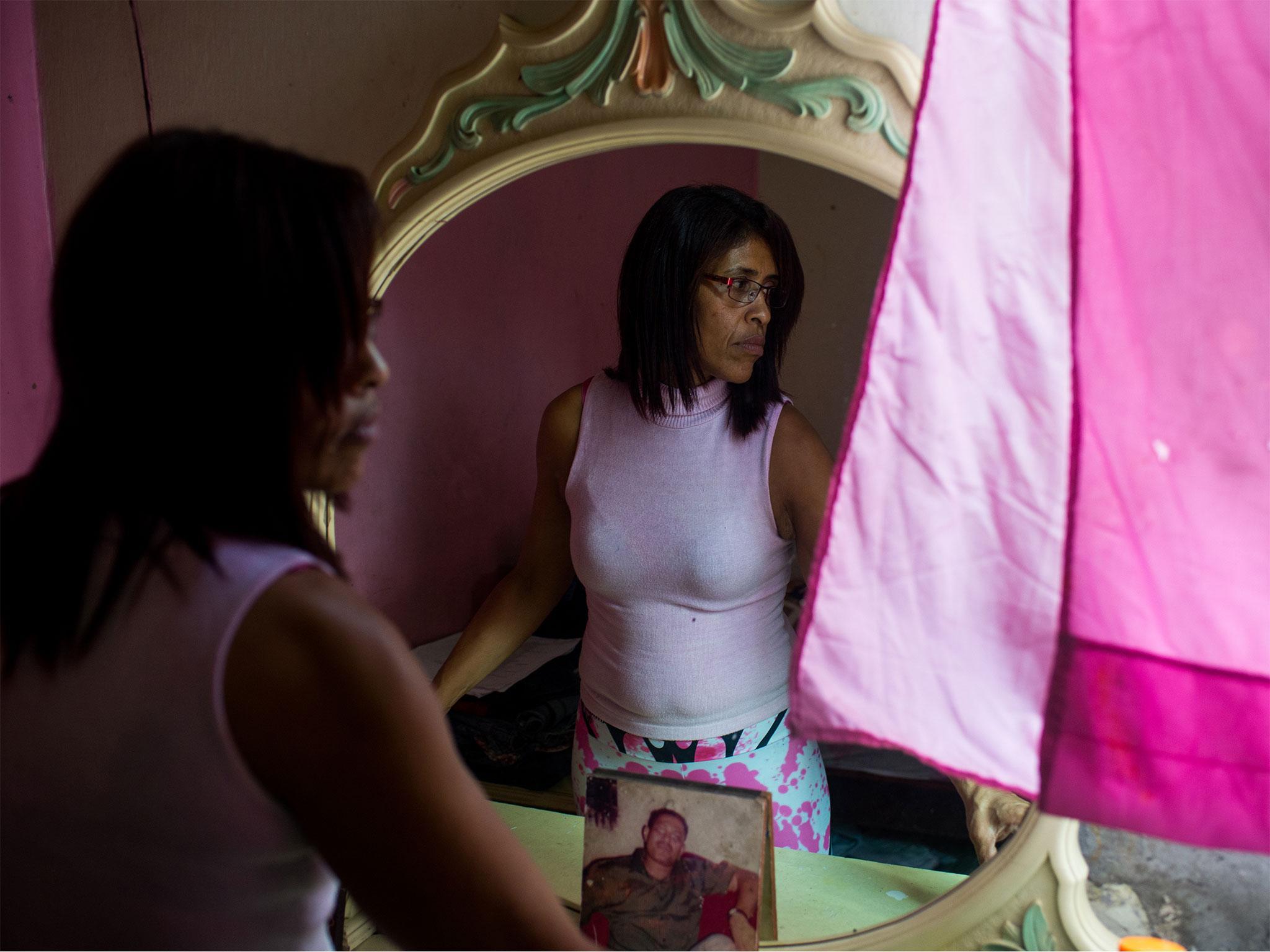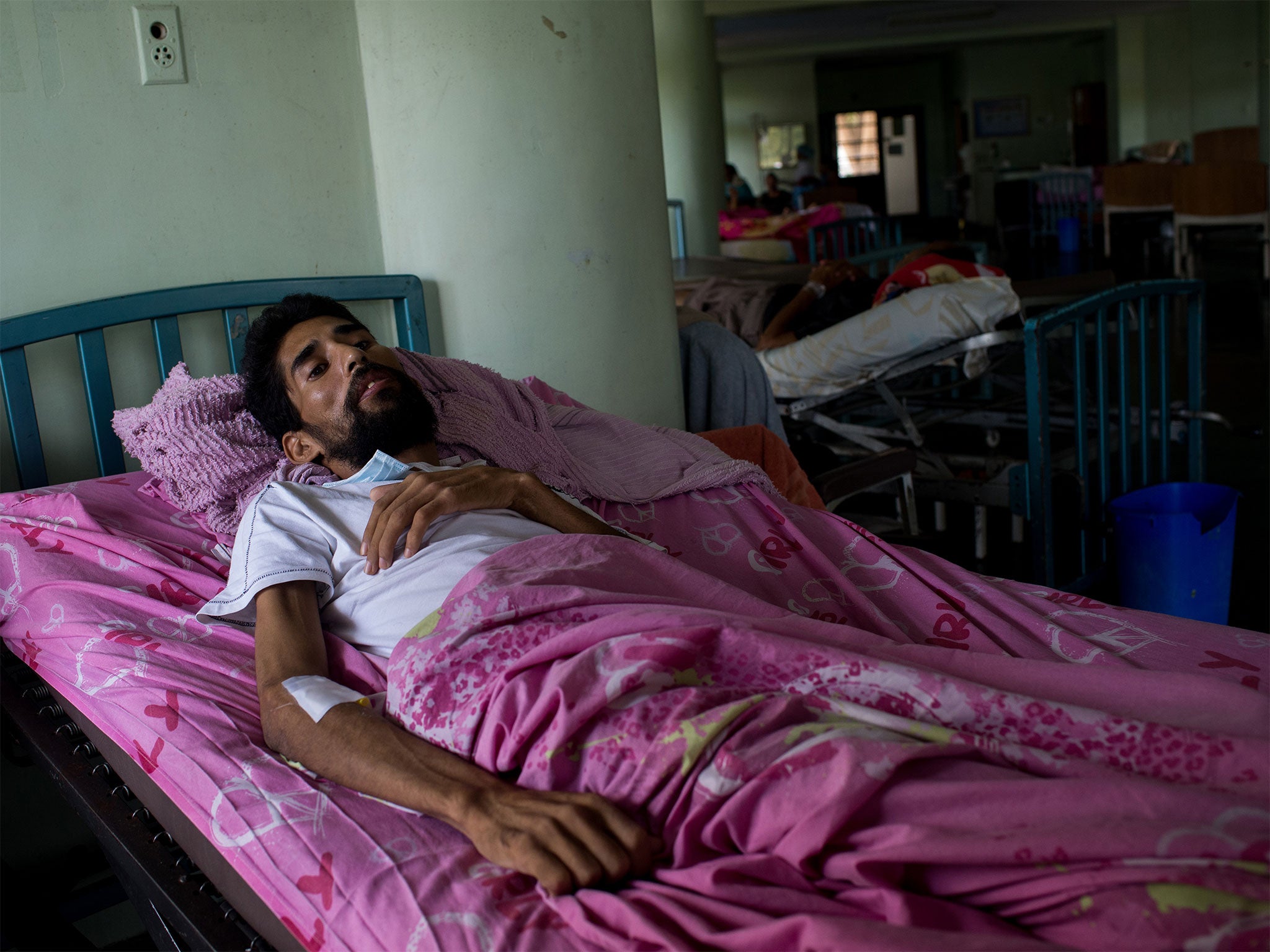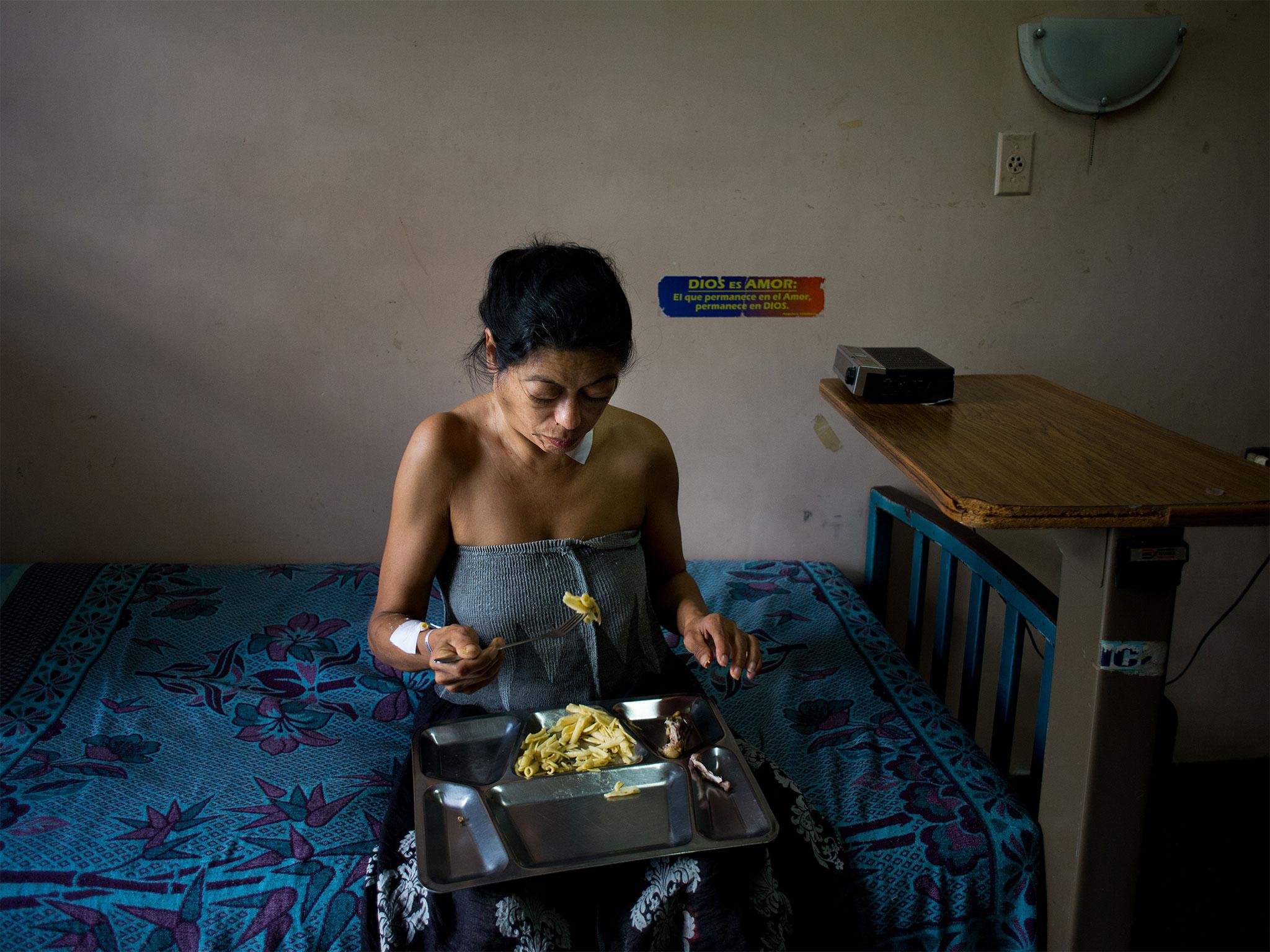Sickness and HIV drug shortages rise as Venezuela's economy crumbles
In a country where a six pack of condoms cost almost a full day's minimum wage, doctors are struggling to cope with a surging HIV/Aids crisis that experts fear could become the worst in Latin America in years

The wheezing bus pulled in late from the slums, so Carmen Hernandez is practically jogging toward the clinic. It opened 20 minutes ago, and she needs to be early. Late means lines, and the 49-year-old mother of five can’t wait.
She’s wasting away.
Her high cheekbones are protruding, and the headaches are getting worse. A fearless tough talker, she doesn’t flinch at the crackle of gunfire on her street. But this is different. She’s dropped eight pounds in four weeks. She’s scared.
“I should be at the clinic already,” she says, her voice on edge.
That would be the state infectious disease clinic, where in July a doctor said the words that meant Venezuela’s chronic shortages had finally ensnared her. With the economy collapsing, many things are hard to find. But this is her Viraday, the HIV drug keeping her alive.
“We have none left,” the doctor had told her. “Try again in August.”
So an hour after first light one August morning, she is doing just that. Her eyebrows furrow as she approached the clinic’s black gates.
Doctors inside are struggling to cope with a surging HIV/Aids crisis that experts fear could become the worst in Latin America in years. In a country where a six-pack of condoms – which can prevent transmission – costs almost a full day’s minimum wage, the number of newly infected patients is jumping. Surging prices and shortages of medicines and food, meanwhile, are hitting those already infected, with increasingly devastating consequences.
“Hola, mi amor,” a grinning guard at the gate says, sizing up Hernandez. She can’t afford breakfast, but she has managed blue eye shadow and a dash of fuchsia on her lips that matches her skintight leggings. His smirk says he knows she's not from around here – a middle-class district. This woman is pure Catia, one of the capital’s toughest slums.

“What are you looking for today, my love?” he says.
She takes a second, hugging herself in a knockoff Adidas jacket that hides the loose skin from her rapid weight loss.
“Viraday,” she says.
“I need Viraday.”
Already living with the world’s highest inflation rate and an increasingly repressive government, Venezuelans are facing an imploding health system.
During the 14-year rule of President Hugo Chávez, a charismatic socialist who died in 2013, oil-rich Venezuela was praised by health experts for its HIV prevention programmes and free treatment. But the national health system is now buckling as years of government mismanagement and corruption, coupled with lower oil prices, have plunged the economy into chaos. Authorities import many drugs, including antiretrovirals, at discounted rates via the Pan American Health Organisation. But the local currency is in free fall, putting those cut-rate drugs, as well as basic imported medical supplies such as needles and saline, increasingly out of reach.
Amid the cascading medical crises is the spike in complications from HIV/Aids. Free HIV tests have been mostly unavailable since November. Pinched by costs, prevention programmes offering free condoms ceased last year. Amid pill shortages, otherwise healthy carriers like Hernandez are going weeks, sometimes months, without antiretroviral drugs.
As a result, Caracas’ largest hospitals are now scrambling to cope with an influx of both newly infected and deteriorating HIV patients, their emaciated bodies evoking the distressing images that defined the virus in the 1980s.
“We used to have about one or two HIV patients a day; now we have four and five, up to 25 a week,” says Maria Eugenia Landaeta, head of infectious diseases at Caracas University Hospital, one of the capital’s largest medical centres. “We’ve had too many patients die because we can’t offer treatment.”
“It is,” she says, “a nightmare.”
According to statistics from the United Nation’s Aids agency, based on information from Venezuela’s health ministry, the number of Aids-related deaths in the country surged 25 per cent to 2,500 between 2010 and 2016, even as they fell 12 per cent on average across Latin America. Many Venezuelan medical experts believe the numbers could be even higher.
The number of newly diagnosed infections in Venezuela fell slightly during the same period, easing to 6,500 from 7,000 annually, according to the figures. But shortages of medication, the lack of tests and the disintegrating economy, experts say, appear to be sharply worsening the HIV crisis now, making the country an outlier in a region that is generally making gains against the virus.

Severe shortages of HIV drugs go back to at least April, doctors say. But before July, the state clinic Hernandez counts on had regularly supplied her with the combination drug Viraday, also known as Atripla. Its powerful compounds act against the enzymes that cause the HIV infection to spread.
“When they told me they ran out, I left, sat down on the street and cried,” says Hernandez. “I couldn’t stop. People passed by and stared.”
Venezuela’s health ministry did not respond to repeated calls and written requests for comment.
The government of Nicolás Maduro, Chavez’s anointed successor, has routinely rejected offers of international humanitarian aid. Nonprofit groups say Venezuelan authorities have refused even small-scale help.
Jesus Aguais, founder of Aid for Aids International, says his nonprofit used to have a permit to bring up to $2m worth of HIV drugs into Venezuela annually. Without citing a reason, the government abruptly refused to renew its licence in 2014, he says.
“We send drugs to 42 countries,” says Aguais. “What is happening in Venezuela hasn’t happened anywhere else.”
The Aids patients at Caracas University Hospital are a vision that haunts Hernandez. Last year, she went to the facility for lab work.
“I remember an extremely skinny one in a wheelchair,” she says. “It affected me.”
Today, some of the hospital’s hallways are darkened by burned-out bulbs; one hallway has a caved-in floor. On a recent day, the 14 beds reserved for HIV patients in the infectious disease ward were filled. So the spillover went to internal medicine, a 150-bed unit that was 40 per cent occupied with patients suffering from HIV/Aids complications.
In one large ward, Aids patients, some wasting and shrivelled, languish in their beds. The stench of diarrhoea floats in the halls; there is little medication to treat it. If patients need IV dips or many antibiotics, they have to buy them.
Many can’t afford it. A destitute 31-year-old Aids patient, a hairdresser who has been splitting his antiretroviral pills in half to make them last, lies in a foetal position in his bed. Skipping doses or taking insufficient amounts of the medication for weeks, doctors say, can increase the virus’ tolerance of HIV drugs, allowing it to spread.
The young man’s feet are scaly and white, a sign of dehydration. His mouth hangs open, his eyes wide in their jutting sockets.
Lacking the right antibiotic to treat him or IVs to rehydrate his rail-thin body, his doctor prescribed an antacid and a plastic bottle for drinking tap water. The complication: The hospital’s water supply, doctors say, had been contaminated by bacteria.
“We can discharge them, which is often safer for them,” says David Flora, a medical resident in the ward.
“Or we can watch them die. Those are really our choices.”
Four days before she went back the clinic in search of meds, Carmen Hernandez strolled through Catia, the western Caracas slum where she was raised, feeling weak.
Her irregular jobs as a hairdresser and errand runner earn her about 60,000 bolivars, or $4 (£3), a week – a sum that doesn’t go very far, even in Catia. Skyrocketing food prices have hit all Venezuelans. For HIV carriers, who require a good calorie intake for their weakened immune systems, they are a crippling blow.
But Hernandez didn’t let the street vendors smell blood.
“How much?” she demanded of a butcher, asking the price of carapacho, or chicken carcasses with the meat removed. It’s a popular dish for a growing number of Venezuelans. They make soups, suck out marrow.
“5,000,” he replied, meaning 5,000 bolivars – about 30 cents.
“What? For bones!” she exclaimed. She puffed air out of her cheeks, moving on.
“They used to give it away for free,” she says.
Thirty minutes later, she’d spent 70 per cent of her weekly salary on three days of food.
Hernandez is down to just tea for breakfast, and usually eats one or two meals later in the day. But prices for some foods – tomatoes, corn flour – have doubled in recent weeks. So she’s cut back even more. She can’t tell if it’s that, or four weeks without Viraday, causing the pounds to fall off.
Last year, her cousin died of HIV complications. She gave in, Hernandez said, by not taking her meds. Hernandez can understand. Life is hard in Venezuela, but it’s a lot harder with HIV.
“I’m scared of decaying,” she says.
Her walk home takes her past a trash heap and up a hill. On the way, there’s graffiti from the pro-government thugs that now run Catia, controlling distribution of subsidised food and instilling fear through violence. Painted on another wall, the eyes of Chávez loom large.
She liked Chávez, even loved him. He fought, she says, for the poor. But under Maduro, she says, people in Catia are casting votes for the government out of fear.
“Everything is a disaster, and they rob so much,” she says.
In her aluminum-walled two-room hut, she occupies herself making tea. These days, her adult children come by sometimes, but none of them are helping her with food. They have families, their own mouths to feed.
She was diagnosed with HIV in 2013. Her husband had recently left her, she says, plunging her into a depression eased by men and liquor. She had no idea who gave her the virus.
“It doesn’t matter,” she says. “I have it.”
After being waved in by the clinic guard on the morning in early August, Hernandez rushes toward a pharmacy window in a small courtyard. She takes a clipboard and signs in.
She sits down on a bench, chewing her lip and watching as patients are called to the window.
One man asks for a different HIV drug. “No, we don’t have it, sorry,” a doctor says. The patient closes his eyes and sighs.
The next man – an older patient – is looking for the same drug.
“Nothing, sir. Hasn’t arrived,” the doctor says.
“Hernandez, Carmen,” a doctor finally calls out from the window.
She rushes forward.
“Viraday,” Hernandez says.
No, they don’t have it.
But they do have the generic.
The doctor tells Hernandez she is lucky. Only 500 monthly doses have arrived for 2,900 patients.
“What happens to the patients who come next week?” Hernandez asks.
The doctor looks down, shaking her head.
© Washington Post
Subscribe to Independent Premium to bookmark this article
Want to bookmark your favourite articles and stories to read or reference later? Start your Independent Premium subscription today.






Join our commenting forum
Join thought-provoking conversations, follow other Independent readers and see their replies
Comments